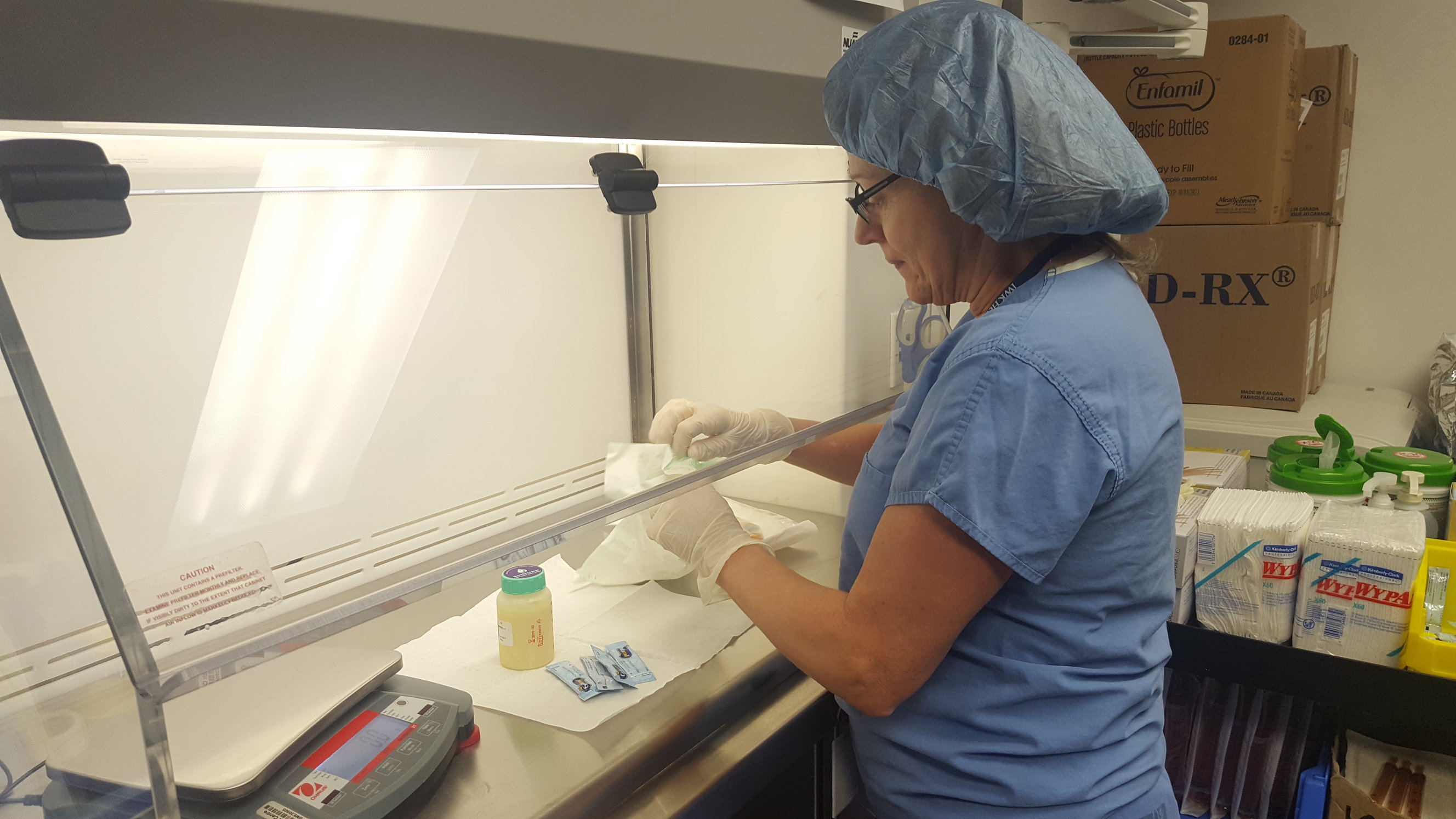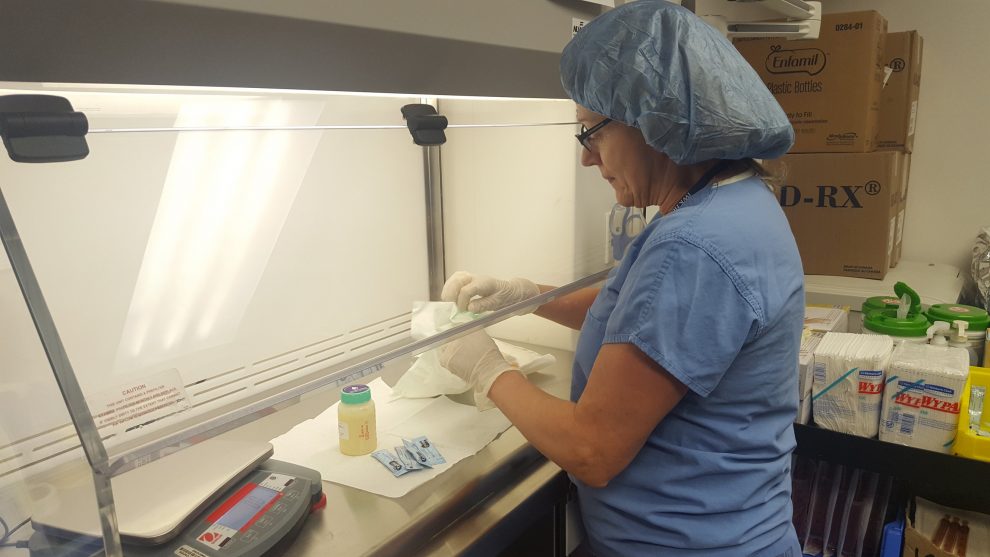Breastfeeding
When Halifax moms need human milk, they turn to Facebook
Some advocates say they want a milk bank to offer safe, pasteurized milk

caption
Dietetic technician Jan Eddy handling donor milk in the Milk Room
caption
Dietetic technician Jan Eddy handling donor milk in the Milk RoomWhen Denika Savoie’s daughter needed more human milk than her mother could produce, Savoie knew she wouldn’t be able to count on her health care system to help her.
“We were told by the IWK Health Centre in Halifax that when a preemie baby reaches what would be 34 weeks gestation that donor milk is no longer provided,” she says in a email.
For the first month, Savoie could feed her daughter with her own milk and the help of donor milk given by the IWK.
But later, when her daughter was two months old, Savoie couldn’t supply an adequate amount of human milk to feed her. She knew from her prior interaction that the IWK would no longer be able to give her any. Looking for an alternative, a family friend suggested she ask a donor to send milk, by putting out a request to the group Human Milk 4 Human Babies on Facebook.
Human Milk 4 Human Babies is one of many human milk groups that operate mostly through social media. Any mother can join and ask for human milk or give their own human milk to mothers in need.
These groups operate on trust; donors are not screened and the milk is not tested. The donor and recipient often meet for the exchange and get to know each other. However, the donor is not liable if her milk has a disease that is transmitted to the baby.
Savoie says that a huge part of why she participates in her milk exchange group is to forge bonds.
“Within the week, I was heading out to meet an amazing mother who provided us with over 500 ounces of milk, as well I received milk from an old elementary school friend who was so happy to have seen the post and be able to provide milk for my daughter,” she says.
At the moment, Savoie and others in need of human milk are left by themselves to find what they need and assess the risk of using milk donated by a stranger.
Kathryn Hayward has been a long-time advocate for the implementation of a human milk bank in Nova Scotia. A professor at the School of Nursing at Dalhousie University, Hayward is part of the Breastfeeding Community of Practise. It’s a group that has been preaching the importance of having a milk bank is Nova Scotia since 2012.
“Because we haven’t had a milk bank here, a lot of moms, for altruistic reasons, want to donate their milk because they recognize the benefits of the milk to the child,” she says. Hayward says that, even with no milk banks in the region, mothers donate their milk and do it instead through online groups like Human Milk 4 Human Babies.
Even if a child fits the criteria to get donor milk, the process is anything but simple. All of the IWK’s human milk orders go to the Northern Star Mother’s Milk Bank in Calgary. The milk is then shipped to Halifax and stored in the IWK’s Milk Room.
All the milk that goes through Calgary is thoroughly screened. Donors go through a multi-step process where they answer questions regarding their lifestyle and medical history and then take a blood test. The milk is then pasteurized in labs, stored and retested while being handled meticulously.
When asked if this process was necessary, the answer for Hayward is simple: “yes.”
The reason for all these precautions is also the reason why there are only a few milk banks in Canada. Almost all of the milk banks closed due to concerns of virus transmission. At the time, the medical community was not confident they would be able to detect viruses in human milk.
“Back in the 80s, we had 20 plus banks across Canada and they all closed except the bank in Vancouver and they all closed because of the HIV scare” says Hayward.
Milk banks have since made a comeback. Toronto has opened a milk bank and Héma-Québec is now doing the same in Quebec. The Atlantic provinces have been left behind.
In 2005, as part of the Thrive! A plan for a Healthier Nova Scotia initiative, the province enacted a policy called The Breastfeeding in Nova Scotia. The policy states that “the Department of Health and the Department of Health Promotion and Protection hold a firm and unequivocal position in favour of breastfeeding and communicates its position both within government, the health system, to health system providers as well as the general population.”
However, in 2016, the IWK was still unable to give human milk to all of the families that need it.
Joyce Ledwidge, a dietitian working at the IWK neonatal intensive care unit (NICU), says that the lack of support from the provincial government is the reason there hasn’t been any real progress in opening a milk bank in Halifax.
“Where we seem to lose momentum revolves around provincial funding,” she says.
Martha Paynter has been a prominent advocate of human milk in Halifax and has made donations to the Calgary bank in the past. She says the lack of progress is due to the lack of demand.
“In the absence of more parents demanding more access to milk, there isn’t the political pressure to expand beyond what we are able to purchase from Calgary,” she says. “And Calgary, at this point, has never said we can’t supply your needs.”
However, those needs are being limited by the strict criteria set by the IWK. They do not make orders that would cover all the mothers that need human milk. Only babies that are born prematurely and are at the NICU can get donor milk for a limited time.
Paynter says that’s a problem because “we have clinical leaders in the NICU advocating for the use of this milk because of the clinical evidence.”
Groups, like Human Milk 4 Human Babies, Eats on Feets and Breastmilk Sharing Nova Scotia, have hundreds of members and show that the demand could be much larger.
